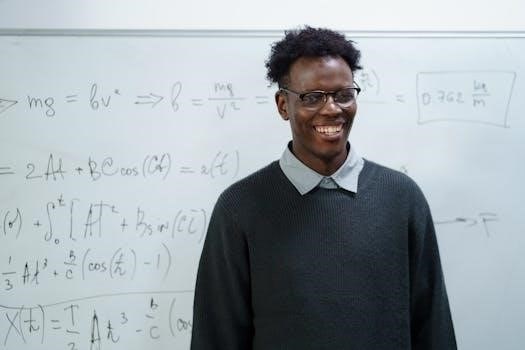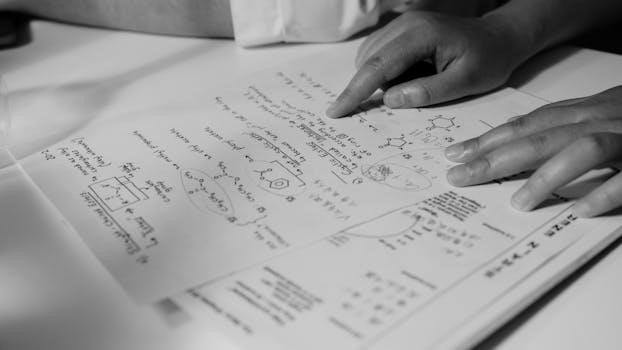Mathematical methods are absolutely fundamental to the physical sciences, providing the language for describing and understanding the universe. These methods form a robust framework, enabling physicists to model, analyze and predict physical phenomena with precision and clarity. Essential mathematical relations and proofs form the backbone of this vital area;
Importance of Mathematics in Physics
Physics, at its core, is a quantitative science that seeks to relate measurements and observable quantities to fundamental laws and principles. Mathematics provides the essential tools and language to express these relationships accurately and rigorously. Without mathematics, many concepts in physics, like quantum mechanics and relativity, would be impossible to formulate or understand. Mathematical methods allow us to transform complex physical phenomena into solvable problems, enabling the prediction of outcomes and advancements in technology. The application of mathematical techniques is not merely a computational tool; it is deeply intertwined with the conceptual development of physical theories. From vector analysis to differential equations, each area of mathematics provides physicists with the ability to describe the intricate workings of the universe, analyze experimental data, and make tangible predictions. The elegance and power of mathematical formulations are central to the progress of physics and the understanding of nature.

Core Mathematical Concepts
Essential for physical science understanding, core concepts include calculus, linear algebra, and differential equations. These form the basis for modeling various physical phenomena, from motion to electromagnetism, offering essential analytical tools.
Calculus and Infinite Series
Calculus, encompassing differential and integral calculus, forms a cornerstone of mathematical methods in physical sciences. It provides the tools to analyze continuous change and rates, vital for understanding motion, fields, and wave phenomena. Differentiation describes instantaneous rates of change, while integration allows for the calculation of areas, volumes, and accumulated quantities. Infinite series, including Taylor and Fourier series, enable the representation of complex functions as sums of simpler terms. These series are fundamental for approximating solutions to equations and are extensively used in analyzing oscillatory behaviors and signal processing. The concept of uniform convergence is crucial for understanding the validity of series expansions. The manipulation of series and the study of their convergence are essential skills for physicists, allowing them to handle complex physical problems effectively. Calculus and series are the tools used to derive and understand fundamental physical laws.
Linear Algebra and Matrices
Linear algebra and matrices provide a powerful framework for analyzing systems of linear equations, transformations, and vector spaces, all crucial in physical sciences. Matrices are used to represent linear transformations, allowing for the manipulation of vectors and the analysis of systems with multiple variables. Eigenvalues and eigenvectors reveal fundamental properties of linear systems, such as stability and resonant frequencies. Vector spaces provide a framework for representing physical quantities with direction and magnitude. The concept of orthogonality is crucial for decomposing vectors into independent components. Matrix operations, including multiplication, inversion, and determinant calculation, form the foundation for solving linear systems and analyzing coupled phenomena. Linear algebra is essential in quantum mechanics, where operators are represented by matrices, and in electromagnetism for solving systems of linear equations that arise from physical laws. The study of matrices and linear transformations is fundamental for understanding many core areas in physics.
Differential Equations
Differential equations are paramount in modeling physical phenomena that involve rates of change, describing how quantities evolve over time or space. They connect a function with its derivatives, allowing for the formulation of dynamical laws and the analysis of systems with evolving states. Ordinary differential equations (ODEs) describe systems with one independent variable, often time, while partial differential equations (PDEs) involve multiple independent variables, such as spatial dimensions and time. Techniques for solving differential equations, including analytical methods and numerical approximations, are crucial for predicting the behavior of systems. From the simple harmonic oscillator to complex fluid dynamics, differential equations provide the mathematical tools to capture the underlying dynamics. In classical mechanics, Newton’s second law is a differential equation. In electromagnetism, Maxwell’s equations are partial differential equations. The study of differential equations allows for the analysis of stability, oscillations, and the long-term behavior of physical systems, making them indispensable in physical sciences.

Advanced Mathematical Methods
Advanced mathematical methods are essential for tackling complex problems in physics, using sophisticated tools such as complex analysis, group theory, and variational methods. These techniques allow for a deeper understanding of physical phenomena.
Complex Analysis
Complex analysis, a branch of mathematics dealing with complex numbers and their functions, is a powerful tool in mathematical physics. It provides elegant solutions to problems that are difficult or impossible to solve using real analysis alone. The use of complex numbers allows for a more complete picture of physical phenomena, especially those involving oscillations and waves. Techniques such as contour integration, residue calculus, and Laurent series expansions are frequently employed to evaluate integrals, analyze singularities, and solve differential equations. Complex analysis also plays a crucial role in quantum mechanics, electromagnetism, and fluid dynamics, among other areas of physics. Its ability to simplify calculations and reveal hidden symmetries makes it an indispensable part of the physicist’s toolkit, offering insights that may not be apparent through real-valued analysis. The ability to apply complex analysis opens up advanced methods for solving complex problems.
Group Theory
Group theory, a mathematical framework for studying symmetry, is a fundamental tool in modern physics. It provides a systematic way to classify and understand the symmetries present in physical systems. This powerful tool allows physicists to analyze the behavior of particles and fields, and to predict the outcomes of experiments. Group theory helps us understand conservation laws and selection rules by relating them to underlying symmetries. It is essential in quantum mechanics, where the symmetry properties of wave functions dictate the quantum states and the allowed transitions between them. In particle physics, group theory is used to classify elementary particles and to understand their interactions. It also plays a critical role in condensed matter physics, in the study of crystal structures and their properties. The application of group theory greatly simplifies complex calculations and reveals essential connections between different physical phenomena, making it a core element of theoretical physics. Its use provides a deeper understanding of fundamental principles.
Variational Methods
Variational methods represent a powerful approach in mathematical physics for finding solutions to problems that involve optimizing a certain quantity. These methods are crucial when direct solutions to differential equations are difficult to obtain. They work by formulating a problem in terms of minimizing or maximizing a functional, often related to energy or action. The core idea is that the solution to a physical problem can be found by identifying the function that makes this functional stationary. These methods find extensive use in classical mechanics, where they provide an alternative formulation of motion using the principle of least action. They are also vital in quantum mechanics for finding approximate solutions to the Schrödinger equation. In field theory, variational methods are used to find equations of motion for fields, and are essential in the study of diverse phenomena ranging from fluid dynamics to the theory of elasticity. The use of variational methods is often key to solving complicated problems.

Applications in Physics
Mathematical methods are fundamental in physics, providing tools to describe the universe. They are used to model phenomena in mechanics, electromagnetism, quantum mechanics, and relativity, enabling accurate predictions and deeper understanding of the physical world.
Mechanics and Electromagnetism

In classical mechanics, mathematical methods are essential for describing motion, forces, and energy. Vector calculus, differential equations, and linear algebra are used extensively to model trajectories, analyze systems of particles, and understand the dynamics of rigid bodies. Electromagnetism relies heavily on mathematical tools to describe electric and magnetic fields. Maxwell’s equations, a set of partial differential equations, form the foundation of electromagnetic theory, necessitating a strong understanding of vector calculus and complex analysis for their solution and interpretation. The use of these mathematical methods allows physicists to predict electromagnetic wave propagation, analyze circuits and understand the interaction between electricity and magnetism. Numerical methods are also employed to model complex electromagnetic phenomena that cannot be solved analytically. These techniques reveal the intricate interplay between mathematical structures and physical reality, offering a profound understanding of our classical universe.
Quantum Mechanics and Relativity
Quantum mechanics and relativity, the cornerstones of modern physics, rely heavily on sophisticated mathematical methods. Quantum mechanics utilizes linear algebra, particularly Hilbert spaces, to represent quantum states and operators. Differential equations, such as the Schrödinger equation, are crucial for describing the time evolution of quantum systems. Probability and statistics play a fundamental role in understanding the inherent probabilistic nature of quantum phenomena. In relativity, tensor analysis and differential geometry are essential for describing spacetime and gravity. Einstein’s field equations of general relativity, for example, are complex tensor equations that require advanced mathematical techniques for their solution. These mathematical tools allow physicists to explore the behavior of particles at the atomic and subatomic level, and to study the structure and evolution of the universe at the largest scales. They reveal the deep mathematical structure underlying the physical reality in domains where classical intuitions break down.
